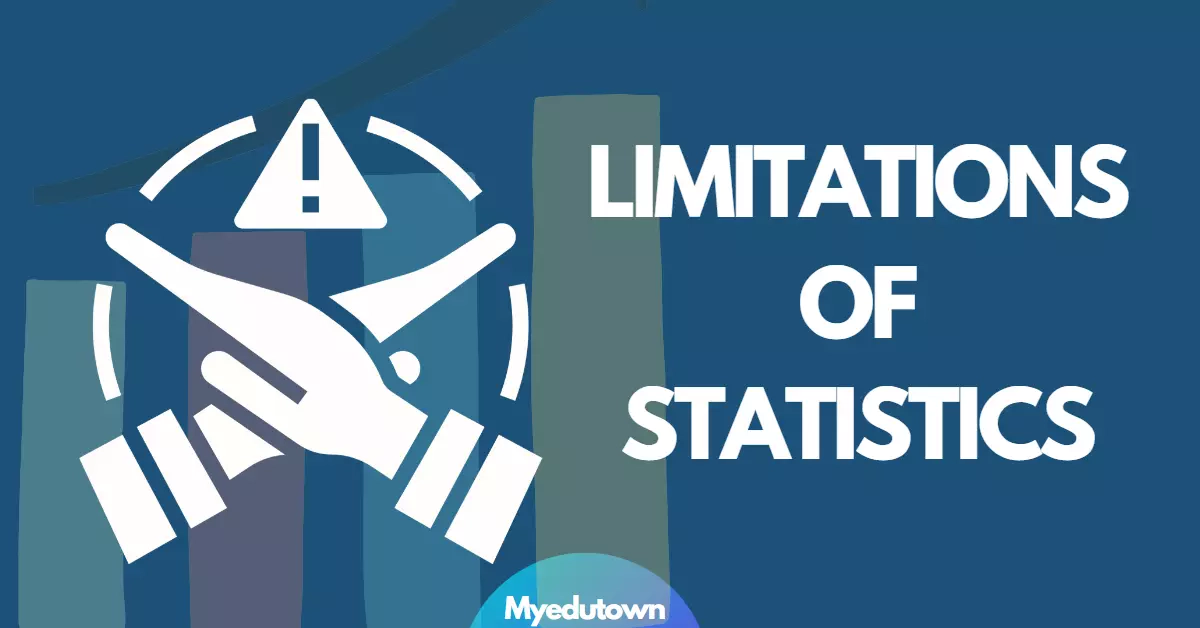Statistics is a powerful tool for understanding and analyzing data, but it is important to be aware of its limitations. There are several factors that can impact the reliability of statistical analyses and lead to inaccurate or misleading results. Understanding these limitations is essential for correctly interpreting the results of statistical analyses and making informed decisions based on the data. Some common limitations of statistics include sampling error, bias, measurement error, nonresponse error, outliers, etc. It is important to carefully consider these limitations when designing and conducting statistical analyses and interpreting the results.

Why is it important to consider the limitations of Statistics
It is essential to consider the limitations of statistics in order to ensure that statistical analyses are reliable and accurate. Without taking these limitations into account, it is possible to draw incorrect conclusions or make inappropriate decisions based on the data. By understanding the limitations of statistics, researchers and analysts can more effectively use statistical tools to draw meaningful insights from data and make informed decisions. Additionally, by acknowledging the limitations of statistical analyses, researchers can be more transparent and honest about the limitations of their work, which can help to build trust and credibility. In short, considering the limitations of statistics is crucial for ensuring that statistical analyses are reliable, accurate, and useful.
20 Limitations of Statistics
1. Sampling error
Sampling error is one of the important Limitations of statistics. This error occurs when the sample used in a statistical analysis is not representative of the entire population. This can lead to inaccurate results, as the characteristics of the sample may not be representative of the population as a whole. For example, a researcher wants to study the attitudes of college students toward climate change. They conduct a survey of 100 students at a large university, but the results of the survey may not accurately represent the attitudes of all college students because the sample was not representative of the entire population.
2. Bias
Bias refers to any systematic error in the design, conduct, or analysis of a study that leads to incorrect conclusions. If the sample used in a statistical analysis is biased in some way, the results of the analysis may not be reliable. For example, a researcher wants to study the effectiveness of a new medication for treating depression. They conduct a clinical trial with 100 participants, but the results of the trial may be biased because the participants were all recruited from a single hospital and may not be representative of the entire population.
Read Similar: Scope of Statistics in Nursing
3. Measurement error
Measurement error occurs when the data collected for statistical analysis is not accurately measured. This can lead to errors in the results of the analysis, as the data may not accurately reflect the true values. For example, a researcher wants to study the relationship between exercise and weight loss. They ask participants to self-report their exercise levels and weight, but the results of the study may be compromised because the self-reported data may not be accurate.
4. Self-selection bias
Self-selection bias occurs when participants in a study are not randomly selected from the population, but rather choose to participate based on certain characteristics. This can lead to a sample that is not representative of the population, and the results of the analysis may not be reliable. For example, a researcher wants to study the effectiveness of a new therapy for anxiety. They advertise the study on social media, and only people who are interested in the therapy participate. The results of the study may not be representative of the general population because the participants were self-selected and may not be representative of the entire population.
5. Nonresponse error
Nonresponse error occurs when some members of the sample do not respond to a survey or study. If the respondents are not representative of the entire population, the results of the analysis may not be reliable. For example, a researcher wants to study the political attitudes of residents in a particular city. They send out 1000 surveys, but only 500 are returned. The results of the survey may not accurately represent the political attitudes of all residents in the city because some people did not respond to the survey.
6. Outliers
Outliers are extreme values in a data set that can distort the results of statistical analysis. These values may be the result of errors in measurement or may represent unusual or atypical observations. For example, a researcher wants to study the relationship between income and happiness. They collect data from 1000 people, but one person reports an extremely high income that is much higher than the rest of the sample. The high income of this one person may distort the results of the analysis.
7. Heterogeneity
Heterogeneity refers to the lack of similarity among the members of a sample. If the members of the sample are not homogeneous, the results of the statistical analysis may not be reliable. For example, a researcher wants to study the relationship between diet and cholesterol levels. They collect data from a sample of people with a wide range of ages, incomes, and health status. The results of the analysis may not be reliable because the sample is not homogeneous and the characteristics of the individuals may affect their cholesterol levels.
8. Confounding variables
Confounding variables are other factors that could affect the results of statistical analysis. If these variables are not controlled for, it may be difficult to determine the true impact of the variable being studied. For example, a researcher wants to study the relationship between exercise and heart health. They collect data from a sample of people who exercise regularly and a sample of people who do not exercise regularly. The results of the analysis may be difficult to interpret because there may be other factors, such as diet and stress levels, that could affect heart health and confound the results of the analysis.
9. Limited sample size
If the sample size used in a statistical analysis is too small, the results of the analysis may not be reliable. This is because a small sample size may not be representative of the entire population, and the results may not be generalizable. For example, a researcher wants to study the effectiveness of a new treatment for cancer. They conduct a clinical trial with only 20 participants, which is not a large enough sample to draw reliable conclusions about the effectiveness of the treatment.
10. Complexity
If the data being analyzed is too complex, it may be difficult to accurately interpret the results of the statistical analysis. This can be due to a large number of variables being studied or the intricate relationships between the variables. For example, a researcher wants to study the relationship between multiple variables, such as age, income, education level, health status, and the likelihood of developing a particular disease. The data may be too complex to accurately interpret, as there may be many different factors that could affect the likelihood of developing the disease.
11. Assumptions
Many statistical techniques rely on certain assumptions about the data, such as the normality of the data or the independence of the observations. If these assumptions are not met, the results of the analysis may be unreliable. For example, a researcher wants to study the relationship between two variables using a statistical technique that assumes that the data is normally distributed. However, the data is not normally distributed, and the results of the analysis may not be reliable.
12. Limited scope
Statistical analysis can only provide insights into the specific data that is being analyzed, and may not be applicable to other situations or contexts. This means that the results of a statistical analysis may not be generalizable beyond the specific data set being studied. For example, a researcher wants to study the effectiveness of a new treatment for cancer. They conduct a clinical trial with a large sample of patients and find that the treatment is effective. However, the results of the study may not be applicable to other types of cancer or to other populations, as the study was conducted on a specific group of patients with a specific type of cancer.
13. Difficulty in interpretation
The results of statistical analysis can be complex and difficult to interpret, especially for those who are not familiar with statistical methods. This can make it challenging to understand and communicate the results of statistical analysis. For example, a researcher conducts statistical analysis and produces a complex table of results with many different p-values and confidence intervals. It may be difficult for someone who is not familiar with statistical methods to understand and interpret the results of the analysis.
14. Software limitations
Some statistical software may have limitations that can impact the accuracy of the results. For example, some software may not be able to handle large data sets or may have difficulty with certain statistical techniques. For example, a researcher wants to analyze a large data set with millions of observations, but the statistical software they are using is not able to handle such a large data set. As a result, the results of the analysis may not be reliable.
15. Human error
Mistakes in data entry, analysis, or interpretation can all lead to errors in the results of statistical analysis. It is important to carefully check and verify the data and the analyses to minimize the risk of errors. Human error can be a limitation in statistical analysis in a number of ways. For example, A researcher may also make a mistake in the calculation of the statistical analyses, such as using the wrong formula or failing to account for a particular variable. Human error can also occur in the interpretation of the results of the analysis, such as by making incorrect assumptions about the meaning of the results or by drawing inappropriate conclusions based on the data.
16. Limited data
If the data available for analysis is limited in some way, it may be difficult to draw reliable conclusions. This can be due to incomplete data or small sample size. For example, a researcher wants to study the relationship between a particular medical condition and a particular treatment. However, they only have access to data from a small number of patients, which may not be sufficient to draw reliable conclusions about the effectiveness of the treatment.
17. Inaccurate data
If the data used in the analysis is inaccurate or unreliable, the results of the analysis will be compromised. It is important to carefully verify the accuracy of the data before conducting a statistical analysis. For example, a researcher wants to study the relationship between air pollution and respiratory health. They collect data on air pollution levels and respiratory health outcomes, but the data on air pollution levels is inaccurate because the measuring devices were not properly calibrated. As a result, the results of the analysis may not be reliable.
18. Limited statistical methods
There may be limitations to the statistical methods that can be used to analyze certain types of data. For example, a researcher wants to study the relationship between two variables that are not normally distributed. However, many statistical techniques assume that the data is normally distributed, and the researcher may not have access to statistical methods that are suitable for non-normal data.
19. Time and cost constraints
Statistical analysis can be time-consuming and expensive, and may not always be feasible depending on the resources available. This can be a limiting factor in the types of statistical analyses that can be conducted. For example, a researcher wants to conduct a large-scale clinical trial to study the effectiveness of a new treatment. However, the trial would be time-consuming and expensive to conduct, and the researcher may not have the resources or funding to complete the study.
20. Ethical considerations
There may be ethical considerations to consider when collecting and analyzing data, such as privacy and confidentiality. It is important to carefully consider these issues and ensure that the data is collected and used in an ethical manner. For example, a researcher wants to study the medical records of patients in a particular hospital. However, they need to ensure that they have obtained the proper ethical approval and that the privacy of the patients is protected in order to conduct the study in an ethical manner. This may be a limiting factor in the types of data that can be collected and analyzed.
Conclusion
In summary, it is essential to be mindful of the various limitations of statistics when conducting and interpreting statistical analyses. These limitations can include a wide range of factors, such as issues with data collection, sample size, and statistical methods. It is important to carefully consider these limitations in order to ensure that the results of statistical analyses are reliable and accurate. By understanding the limitations of statistics, researchers and analysts can more effectively use statistical tools to draw meaningful insights from data.




